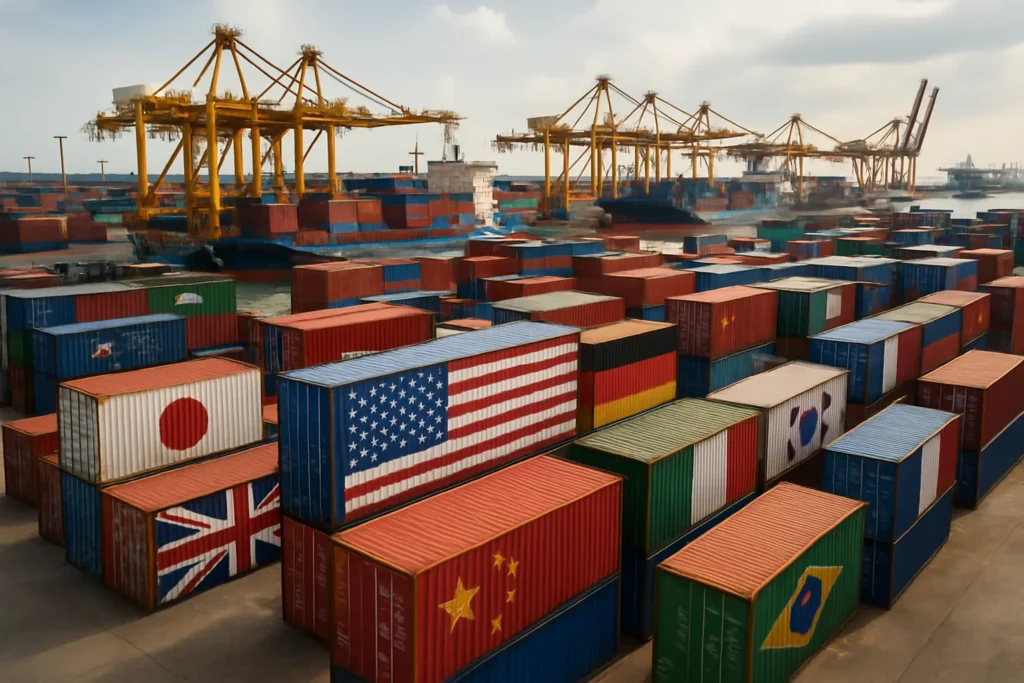The Trade War Hits: Tariffs Bite, Strategies Shift
Picture this: Vast warehouses along the U.S. West Coast suddenly fill with unsold Chinese goods. Dockworkers watch ships arrive half-empty. The atmospheric churn of global commerce, long marked by the easy flow of “Made in China” products, is visibly disrupted. In April, official Chinese customs data recorded a 17.6% month-on-month plunge in exports to the U.S.—down a staggering $7 billion—in the wake of 145% tariffs imposed on everything from electronics to clothing. This is not some theoretical trade spat: it’s a daily economic reality stretching from Guangzhou factories to Omaha hardware aisles.
What caused this abrupt shift? President Trump’s tariff blitz, deployed in early 2025 after months of brinkmanship, was intended to force Beijing’s hand. American officials claimed that only punitive measures could address China’s trade surplus and alleged intellectual property abuses. The Chinese response? Both predictable—retaliatory tariffs of up to 125%—and creative. According to official data and market analysts cited by Bloomberg and Reuters, China’s overall exports didn’t just survive, they grew by 8.1% year-on-year in April, defying market expectations of a meager 2% rise. Their secret weapon: a rapid, strategic reorientation of trade flows away from the United States toward new frontiers.
Harvard trade policy expert Susan Li notes, “When tariffs bite, smart economies pivot. The Chinese export model has proven remarkably adaptive. Losing American buyers, China found new ones with stunning speed.” Shipments to Southeast Asia and Europe surged by double digits, particularly to Vietnam, Indonesia, and Thailand. That “structural repositioning” is now a defining global trend, and no longer just an economic abstraction—American and Chinese workers alike are feeling the chill.
Supply Chains in Flux: Winners, Losers, and Risky Shortages
Container ships that once plied routine routes from Shanghai to Los Angeles now reroute, their holds newly destined for Jakarta and Rotterdam. The world’s largest shipping line, Maersk, reported a whopping 30-40% drop in China-U.S. cargo volumes in April. Maersk CEO Vincent Clerc told CNN, “Customers reacted very, very fast. They started to withdraw inventory commitments, postpone orders, or seek new suppliers altogether—in some cases, practically overnight.”
Clerc also sounded alarms about the meaner aftermath: Potential shortages of critical goods like solar panels and batteries if the standoff lingers. Such gaps threaten to undercut not only manufacturers but also efforts to build out renewable energy infrastructure—a clear blow to climate progress that hits global priorities. American importers, wary of shelling out additional tariffs, raced to stockpile goods ahead of the hike. The short-term boost, however, gave way to longer-term contraction as the first quarter of 2025 saw the U.S. economy shrink for the first time in three years. “It’s a whiplash effect,” said Jennifer Harris, senior fellow at the Council on Foreign Relations. “The tariff politics that promise to restore jobs actually ricochet, cutting output and forcing higher consumer costs.”
“The Chinese export model has proven remarkably adaptive. Losing American buyers, China found new ones with stunning speed.”
– Susan Li, Harvard trade policy expert
This global game of economic musical chairs echoes earlier periods of trade tension—from Reagan-era tariffs on Japanese cars to Bush’s steel duties in the early 2000s. Yet, as Princeton economist Alan Blinder reminds us, “Supply chains today are far more complex, and disruptions cascade faster and harder than ever before.” Household electronics, clothing, and even electric vehicles now depend on assembly lines that stretch across dozens of borders. Any break—especially one as abrupt as a sweeping tariff regime—inevitably ripples out, squeezing smaller economies and consumers, not just giant exporters or importers.
The Human Side: What the Numbers Don’t Reveal
A closer look reveals that, while aggregate trade numbers may signal resilience, the on-the-ground consequences for real people are sharper and less forgiving. Chinese factory workers furloughed as U.S. orders vanish, American warehouse staff face layoffs as inventory sits idle, and family-owned suppliers from Missouri to Guangzhou wonder when stability will return. The rhetoric of “winning” or “losing” overlooks the nuanced truth: both sides are recalibrating under duress, with ordinary people bearing the brunt.
Diversification of trade partners has prompted more Chinese investment and outreach to neighboring Asian economies. Southeast Asia now finds itself the sudden darling of Chinese exporters, its ports bustling with new activity and logistics firms scrambling to keep up. Yet, this boon comes with risks: can these nations absorb such a surge without infrastructure bottlenecks or labor abuses? The risk of a race to the bottom is ever-present.
Against this backdrop, Treasury Secretary Scott Bessent, leading the U.S. delegation in Geneva talks, faces a tough question: is the cost to American families and global stability really worth the price of a headline-making trade war? Vice Premier He Lifeng, helming China’s team, must weigh similar concerns—how many jobs, how much growth, can be sacrificed without risking unrest at home?
Trade policy, much like the goods themselves, travels far beyond government edicts or quarterly numbers. It permeates the daily rhythm of global commerce and the livelihoods of millions. As talks progress, will either side recognize that punitive tariffs rarely offer the simple solutions politicians promise? History suggests the road to stable prosperity is paved not with confrontation, but with negotiation and compromise. For now, the world holds its breath, as the containers are reloaded, the deals are redrawn—and both challenge and opportunity ride the tides of change.

